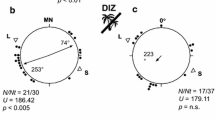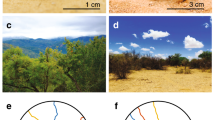Abstract
Preliminary studies carried out on a population of Sphaeroma serratum have shown that this isopod uses the mechanism of sun compass to orient in the water. However, it appears that several environmental factors can influence this mechanism. The aim of this study was to check the sun compass in a population collected in the Ghar El Melh lagoon. Orientation experiments were realized in spring 2019: control experiments were carried out in the field, at the edge of the lagoon of Ghar El Melh lagoon (GMLE) and in an open space at the Faculty of Science of Tunis (FST). The experiments were carried out during three periods of the day: around 9:00, 12:00, and 15:00 using a circular arena filled with water, with (L) and without (S) the possibility of landscape view. Data analyses were performed using statistical tests of circular distribution data. To analyze the intervening factors in the solar orientation behavior of S. serratum a multiple regression analysis adapted to circular data (SPLM - spherically projected linear models) was used. Orientation angles were used as response variables, while factors as: landscape view (L or S), locality of the experiment (GMLE or FST), solar azimuth (azim), sky cloud degree (0–8), sun (visible, covered, shape, not visible) and time of the experiment, were used as influencing variables. The results showed that also the Ghar El Melh S. serratum use the sun azimuth to orient in the water. It resulted that the locality of the experiment significantly influenced their orientation, while the time of experiment had a minor effect.



Similar content being viewed by others
References
Amor KOB, Amor MMB, Rifi M, Souissi JB (2017) Diversity of crustacean species from Tunis Southern Lagoon (Central Mediterranean) after an ecological restoration. Cah Biol Mar 58:49–57. https://doi.org/10.21411/CBM.A.CC457186
Bejaoui S, Bouziz M, Ghribi F, Chetoui I, M’hamed EL (2019) Assessment of the biochemical and nutritional values of Venerupis decussata from Tunisian lagoons submitted to different anthropogenic ranks. Environ Sci Pollut Res 27(2):1734–1751. https://doi.org/10.1007/s11356-019-06851-y
Ben Souissi E, Hamaied S, Medini Bouaziz L (2016) Etude de la phénologie de la reproduction de Sphaeroma serratum de la plage de Menzel Abderrahmane. In: Bull Inst Nat Sci Tech Mer de Salammbô, N° special 19, Actes des Seizièmes Journées des Sciences de la Mer, Zarzis, Tunisie, pp 32–36
Bohli-Abderrazak D, Ayari A, Morgan E, Nasri-Ammar K (2012) Towards a characterization of the locomotor activity rhythm of the supralittoral isopod Tylos europaeus. Chronobiol Int 29(2):166–174. https://doi.org/10.3109/07420528.2011.652327
Borgioli C, Martelli L, Porri F, Marchetti GM, Scapini F (1999) Orientation in Talitrus saltator (Montagu): trends in intrapopulation variability related to environmental and intrinsic factors. J Exp Mar Biol Ecol 238(1):29–47. https://doi.org/10.1016/S0022-0981(99)00012-X
Bourguiba K, El Gtari M (2017) First study of the solar orientation behavior in the marine isopod Sphaeroma serratum (Fabricius, 1787). In: Proceedings TJASSST 2017, Water & Environment, pp 133-136
El Gtari M (2004) Éco éthologie comparée de quelques espèces clés d’arthropodes semis-terrestres et côtiers et systématique d’amphipodes littoraux de la Tunisie. Thèse de Doctorat.Université de Tunis, ELMANAR
El Gtari M, Akremi A, Tiri B, Zaatouri A, Bourguiba K (2017) Pollution’s effect on sun compass mechanism in Talitrus saltator (Montagu 1808) of the Corniche beach of Bizerte (North Tunisia). In: Proceedings TJASSST 2017, Water & Environment, pp 137-140
El Gtari M, Bourigua N, Bouslama MF, Charfi-Cheikhrouha F, Scapini F (2014) Experimental change of the orientation of two populations of Talitrus saltator (Crustacea Amphipoda Talitridae) from Cap Bon (North-Eastern Tunisia). Ethology 120(12):1155–1166. https://doi.org/10.1111/eth.12289
El Gtari M, Bouslama MF, Charfi-Cheikhrouha F, Scapini F (2000a) Orientation solaire, Repères Visuels et Sensibilité à la Variation de la ligne du rivage de deux populations de Talitrus saltator (Crustacé, Amphipode, Talitridé) du Cap Bon (Tunisie). Bull Assoc Tunisienne Sci Mer 5:81–84
El Gtari M, Charfi-Cheikhrouha F, Marchetti G, Scapini F (2000b) Behavioural adaptation of Talitrus saltator populations to beaches with different dynamics and degree of human disturbance along Tunisian coasts. Pol Arch Hydrobiol 47:3–4
Jacobs BJM (1987) A taxonomic revision of the European, Mediterranean and NW. African species generally placed in Sphaeroma Bosc, 1802 (Isopoda, Flabellifera, Sphaeromatidae) No. 238. Rijksmuseum van Natuurlijke Historie, Leiden
Khemaissia H, Nasri-Ammar K (2010) Caractérisation du cycle reproducteur des femelles de Porcellio lamellatus (isopoda, oniscidea) provenant des berges de la lagune de Bizerte (Tunisie). Crustaceana 83(3):1025–1034. https://doi.org/10.1163/001121610X510642
Marchetti GM, Scapini F (2003) Use of multiple regression models in the study of sandhopper orientation under natural conditions. Estuar Coast Shelf Sci 58:207–215. https://doi.org/10.1016/S0272-7714(03)00047-7
Pardi L (1954) Über die Orientierung von Tylos latreillii Aud. & Sav. (Isopoda terrestria). Z Tierpsychol 11(2):175–181
Pardi L (1955) L’orientamento diurno di Tylos latreillii (Aud. e Sav.) (Crustacea Isopoda terrestra). Boll Ist Mus Zool Univ Torino 4:167–196
Rezig M (1975) Comparaison morphologique, biologique et génétique des espèces tunisiennes du genre Sphaeroma (isopodes flabellifères). Etude comparé du cycle biologique de quleques espèces du genre Sphaeroma (isopodes flabellifères) en Tunisie. Thèse de Doctorat, L’Université de Tunis
Rezig M (1979) Etude comparée du cycle biologique de quelques espèces du genre Sphaeroma (Isopodes flabelliferes) en Tunisie. Bull. Inst. Natn. Scient. Tech. Océanogr. Pêche Salammbô 6(1-4):93-121
Rossano C, Di Cristina G, Scapini F (2013) Life cycle and behavioural traits of Dikerogammarus villosus (Sowinsky, 1894) (Amphipoda, Gammaridae) colonising an artificial fresh water basin in Tuscany (central Italy). Crustaceana 86(7–8):908–931. https://doi.org/10.1163/15685403-00003211
Said AB, Bohli-Abderrazek D, Jelassi R, Nasri-Ammar K (2018) Locomotor behaviour of three sympatric species Ligia italica, Armadillo officinalis and Chaetophiloscia elongata (Crustacea, Oniscidea) from Ghar El Melh lagoon (Northeast Tunisia). Biol Rhythm Res 51(3):338–348
Scapini F, Aloia A, Bouslama MF, Chelazzi L, Colombini I, El Gtari M, Marchetti GM (2002) Multiple regression analysis of the sources of variation in orientation of two sympatric sandhoppers, Talitrus saltator and Talorchestia brito, from an exposed Mediterranean beach. Behav Ecol Sociobiol 51(5):403–414
Scapini F, Audoglio M, Chelazzi L, Colombini I, Fallaci M (1997) Astronomical, landscape and climatic factors influencing oriented movements of Talitrus saltator in nature. Mar Biol 128(1):63–72. https://doi.org/10.1007/s002270050069
Scapini F, Gambineri S, Rossano C, El Gtari M, Fanini L, Nourisson DH (2015) Talitrid orientation as bioindicator of shoreline stability: Protected headland-bays versus exposed extended beaches. Ecol Indic 53:28–36. https://doi.org/10.1016/j.ecolind.2015.01.012
Scapini F, Pardi A (1979) Nuovi dati sulla tendenza direzionale innata nell’orientamento solare degli amfipodi litorali. Rendiconti delle Classe di Scienze fisiche mattematiche e naturale 66(8):592–597
Ugolini A, Morabito F, Taiti S (1995) Innate landward orientation in the littoral isopod Tylos europaeus. Ethol Ecol Evol 7(4):387–391. https://doi.org/10.1080/08927014.1995.9522946
Acknowledgements
The present study was supported by the Laboratory of Diversity, Management and Conservation of Biological Systems (LR18ES06), Faculty of Sciences of Tunis, University of Tunis El Manar, Tunis, Tunisia.
Author information
Authors and Affiliations
Corresponding author
Ethics declarations
Ethical approval
All applicable international, national, and/or institutional guidelines for the care and use of animals were followed.
Conflict of interest
The authors declare that they have no conflict of interest.
Additional information
Publisher’s note
Springer Nature remains neutral with regard to jurisdictional claims in published maps and institutional affiliations.
Rights and permissions
About this article
Cite this article
Bourguiba, K., Nasri-Ammar, K., Gambineri, S. et al. Solar orientation in Sphaeroma serratum from Ghar El Melh lagoon (Northern Tunisia). Biologia 76, 943–948 (2021). https://doi.org/10.2478/s11756-020-00615-7
Received:
Accepted:
Published:
Issue Date:
DOI: https://doi.org/10.2478/s11756-020-00615-7




